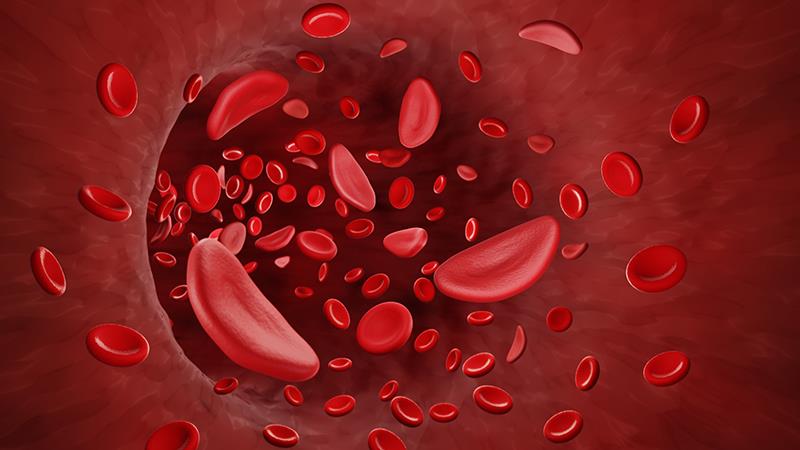Etavopivat reduces VOCs in patients with sickle cell disease





Once-daily treatment with etavopivat results in lower rates of annualized vaso-occlusive crises (VOCs) in patients with sickle cell disease (SCD) compared with placebo, according to the HIBISCUS trial presented at ASH 2024.
Etavopivat, an investigational, once-daily, oral, selective erythrocyte pyruvate kinase (PKR) activator being developed for the treatment of SCD and other haemoglobinopathies. [Blood Adv 2024;8:4459-4475]
Previous studies have shown that etavopivat-mediated activation of PKR decreases 2,3-diphosphoglycerate and increases adenosine triphosphate levels in red blood cells, which may increase oxygen affinity, reduce haemolysis, and decrease VOCs. [Blood Adv 2024;8:4459-4475; J Pharmacol Exp Ther 2022;380:210-219]
The phase II HIBISCUS trial analysed 60 patients (mean age 33.5 years) with any SCD genotype who were on standard-of-care treatments (hydroxyurea, crizanlizumab, or L-glutamine) for ≥6 months prior to randomization. Baseline haemoglobin level was 8.4 g/dL. Participants were randomized in a 1:1:1 ratio to receive etavopivat 200 mg (n=21) or 400 mg (n=20) or placebo (n=19) once/daily for 52 weeks.
In the intention-to-treat (ITT) population (n=60), the VOC rate was reduced by 45 percent and 46 percent in patients treated with etavopivat 200 or 400 mg, respectively, compared with placebo at week 52.
The annualized VOC rates were 1.07 in the 200-mg etavopivat cohort and 1.06 in the 400-mg etavopivat cohort compared with 1.97 in the placebo cohort, favouring the etavopivat regimen. [ASH 2024, abstract 179]
In the per-protocol population (n=40), VOC rates were reduced by 63 percent in the etavopivat 200-mg cohort and 61 percent in the 400-mg cohort compared with the placebo group, with annualized VOC rates of 0.66, 0.70, and 1.77, respectively.
A longer median time to the first VOC was also observed with etavopivat than with placebo (33.6 [in each dose group] vs 16.9 months).
At week 24, the proportion of haemoglobin responders, defined as individuals who had a >1.0 g/dL increase in haemoglobin level, was higher among those treated with etavopivat than those treated with placebo in both the ITT (38.1 percent [200 mg] and 25 percent [400 mg] vs 10.5 percent) and per-protocol (46.2 percent [200 mg] and 33.3 percent [400 mg] vs 13.3 percent) populations.
Of note, the improvement in haemoglobin levels with etavopivat was evident as early as week 2 and maintained through 52 weeks, said Dr Sophia Delicou from Hippokrateio General Hospital, Athens, Greece.
Secondary endpoints
All haemolysis biomarkers, including absolute reticulocyte count, indirect bilirubin, and lactate dehydrogenase, decreased from baseline to week 24 among patients treated with either dose of etavopivat compared with placebo.
Additionally, patients receiving etavopivat 200 or 400 mg had greater reductions in PROMIS Fatigue Scale scores from baseline to week 52 (least squares mean difference, -2.1 and -3.7, respectively) than those receiving placebo.
Adverse events
In terms of safety, serious treatment-emergent adverse events (TEAEs) occurred in five and four participants in the etavopivat 200- and 400-mg groups, respectively, and three participants in the placebo group.
Two patients in the etavopivat 200-mg cohort discontinued treatment due to AEs, whereas none were observed in the etavopivat 400-mg cohort.
Most TEAEs reported were sickle cell anaemia with crisis, nausea, headache, urinary tract infection, vomiting, and insomnia, which were considered mild to moderate in severity.
“Etavopivat was well tolerated, with no unexpected safety issues identified,” Delicou noted.
“Overall, compared with placebo, etavopivat reduced annualized VOC rate through week 52, increased Hb levels at week 24, and improved haemolysis markers and patient-reported fatigue, consistent with potential clinical benefit,” said Delicou.
“Based on pharmacokinetics, pharmacodynamics, and dose-efficacy response modelling analysis using 12-week data, the Data and Safety Monitoring Board selected the 400 mg/day dosage of etavopivat for study in confirmatory phase III trials,” she noted.